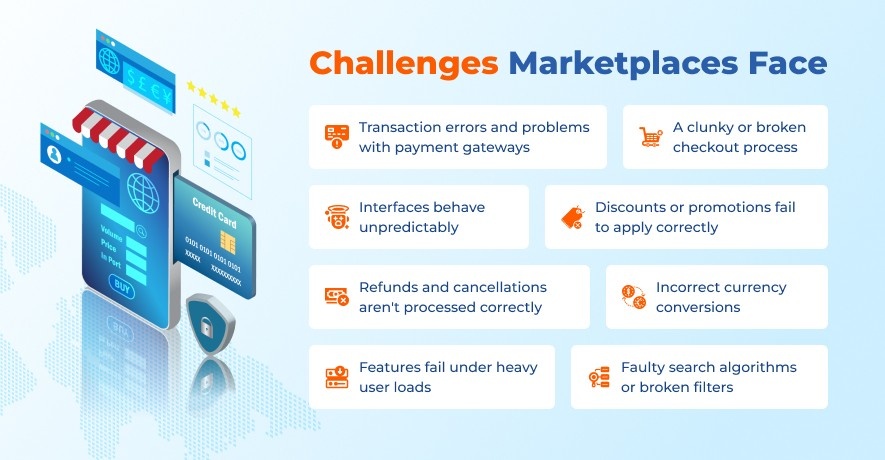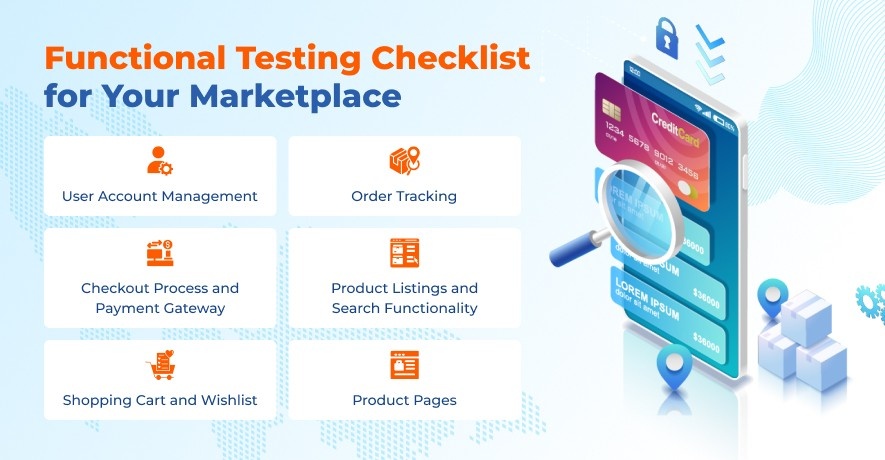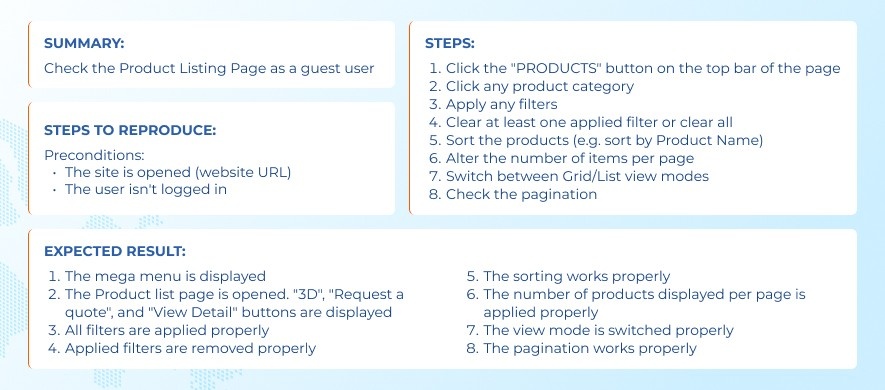Functional Testing for Online Marketplaces
by Yulia Lomanova | December 22, 2020 8:05 am
Online marketplaces will still be a driver of global commerce in 2025. According to eMarketer[1], marketplace sales will reach $603.2 billion by 2027. Platforms like Amazon, eBay, and Walmart are more than just sales channels; they’re dynamic ecosystems where companies compete for visibility and market share.
Because countless competitors are vying for consumers’ attention, standing out means delivering an exceptional user experience. You need to set your service apart by ensuring everything is of the highest quality – from the user interface to the internal system operations and interactions. Take Amazon as an example. Its success isn’t just about the breadth of its products – it’s about providing a seamless and intuitive user experience.
There are 5 major functional requirements for marketplace websites that define the winner of the market competition. The list involves speed, ease of use, accessibility, mobile-friendliness, and personalization. Software testing allows for assessing whether the product meets the quality criteria with each requirement.
In this article, we’ll focus on functional testing of the marketplace and how to write functional test cases. It is a must-read for everyone who wants to verify that their software actually works.
Challenges Marketplaces Face

Marketplaces are at the forefront of digital transformation, but their complex ecosystems come with unique challenges.
- Transaction errors, such as double charges, incorrect totals, or failed payments, frustrate users and damage trust. Problems with payment gateways, shipping providers, or third-party integrations disrupt the user experience.
- A clunky or broken checkout process leads to cart abandonment and lost sales.
- Interfaces behave unpredictably, causing confusion and a poor user experience.
- Discounts or promotions fail to apply correctly, leading to customer dissatisfaction or lost revenue for the company.
- Refunds and cancellations don’t process correctly, frustrating customers and impacting trust.
- Currency conversions, tax calculations, or regional settings are applied incorrectly, causing discrepancies.
- Features like adding items to the cart or processing orders fail under heavy user loads.
- Users struggle to find the right products due to faulty search algorithms or broken filters.
What is Functional Testing?
Functional testing[2] is a group of testing types in which the product is tested against the functional requirements. Its primary goal is to simulate how customers use the system and identify problems – such as missing functionality, UI errors, or integration issues – that could ruin the user experience.
Generally, functional testing may involve particular challenges. First of all, it needs careful planning that would cover all the possible user journeys – even unusual or non-obvious ones. Next, there is always a large number of detailed tests to perform, as they should cover a specific user flow in its entirety. Finally, test analysis. It is sometimes required to verify that actions on the frontend have triggered the correct result on the backend – like making sure that new orders reach the backend system when we test a marketplace.
Functional testing can be done manually or with automated test scripts. Test automation[3] brings many benefits, including tests that can be run 24/7 without human intervention and don’t make errors – this means the whole process will be completed in a much shorter time. The QATestLab’s team of experienced testers and QA automation engineers helps businesses with both approaches and guarantees the maximum quality of their software.
Functional Testing Checklist for Your Marketplace

1. User Account Management
- Ensure that user actions such as account creation, login, and logout work smoothly.
- Validate the functionality of user profile updates and password changes.
- Check the functionality of order history and tracking features.
2. Product Listings and Search Functionality
- Ensure users can search for products using various search terms.
- Confirm that search results display relevant products with correct prices, descriptions, and images.
- Validate the functionality of filtering options.
3. Product Pages
- Ensure the accuracy and consistency of product information.
- Validate the correct loading and display of product images.
- Test the proper functionality of variations such as color and size selection.
- Confirm real-time updates to stock status on product pages.
- Verify the smooth operation of the “Add to Cart” button.
- Check the page loads quickly to prevent freezing caused by large amounts of content.
4. Shopping Cart and Wishlist
- Verify that users can add, edit, and remove products from the shopping cart and wishlist.
- Confirm that items in the shopping cart remain unchanged when users navigate to other pages.
5. Checkout Process and Payment Gateway
- Ensure the checkout process lets users input payment and shipping details and complete their purchases successfully.
- Validate the accurate calculation of shopping costs during the checkout process.
- Make sure different payment methods, like using a credit card or PayPal, work correctly.
6. Order Tracking
- Ensure order confirmations are sent accurately and promptly.
- Validate that order status updates occur in real-time and display correctly.
- Test the seamless processing of return and exchange requests.
How to Write Functional Test Cases for Marketplace Software
A test case[4] is a set of preconditions, procedures (inputs or actions), and expected results used to determine whether a system works correctly. Test cases should have the following structure:
- a brief statement of purpose,
- description of precondition,
- actual test case inputs,
- expected outputs,
- description of expected postconditions,
- execution history (date/person in charge/product version/pass or fail result).
Use our marketplace functional testing checklist to ensure the full coverage for the product:
- Registration and User Profile Management
- Add-to-Cart/Add-to-Wishlist Functionality
- Checkout Functionality
- Order Management System
- User Permissions
- Front-End/Back-End Integration
- Promotions
E-commerce Software Testing: Functional Test Case Example #1

E-commerce Software Testing: Functional Test Case Example #2

Final Words
Marketplaces need to be thoroughly tested to ensure a seamless, enjoyable, and efficient experience for all users on both sides. Every interaction matters – from the first interaction with software to the final click of the checkout button, everything must work seamlessly to build trust and drive success.
Our skilled QA engineers ensure that every aspect of your service functions as intended. Whether it’s testing a new feature or refining a complex system, we’re passionate about helping marketplaces excel and stand out from the competition. Don’t just compete – stand out! Start testing your marketplace today!
 [5]
[5]Learn more from QATestLab
Related Posts:
- eMarketer: https://www.emarketer.com/content/online-marketplaces-top-600-billion-us-retail-sales-2027
- Functional testing: https://go.qatestlab.com/36
- Test automation: https://go.qatestlab.com/26
- test case: https://go.qatestlab.com/38
- [Image]: https://go.qatestlab.com/65
Source URL: https://blog.qatestlab.com/2020/12/22/functional-test-cases-ecommerce/

